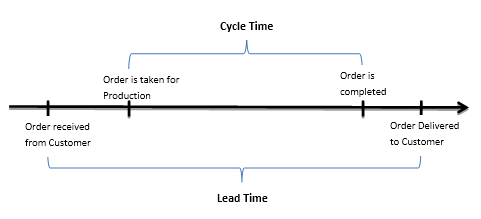Cycle time is all about the speed of delivery of the product/service to the market or customer. In order to understand the concept of Cycle time and to effectively manage it in our business or work place, one needs to know the answer to the following questions:
- What is Cycle time?
- Is Cycle time and Lead time the same?
- How is Cycle time significant in Revenue/Market perspective?
- How should one manage Cycle time for the benefit of their organization and customers?
Cycle time is the time taken from the start of production of a particular unit to the completion of production. So, it is an internal metric and may not be visible to the customer. It signifies the effort spent on making the product.
Cycle time = Production time + Waiting time for Production
On the other hand Lead time is the time taken from the request for an order till the delivery of the order. It is an external metric and hence it is visible to your customers. It signifies the speed of delivery to the customer. The below picture explains the difference between both the Cycle time and Lead time.
The significance of Cycle time:
- Lesser the Cycle time, lesser is the Lead time to market and hence the organization can launch products to market much earlier. For example a smartphone market is very demanding with new enhanced features resulting in launching of new models every week, which shows that the Cycle time of manufacturing is reducing. Here the Cycle Time is of prime importance as this will directly reflect on the sales of the product.
- If the Cycle time of an organization is lesser than their competitors then they get a competitive advantage in the market. So, comparatively they will get higher preference from customers.
- Lesser Cycle time signifies higher efficiency; lower cost and time spent is lesser and hence Profitability and ROI increases.
- Customer satisfaction will be high as the products are delivered before their expected delivery time.
- Productivity increases as the Cycle time decreases. Hence, it can be predicted that the process is streamlined resulting in higher employee morale.
- Cycle time reduction is achieved by reducing the time spent on non-value added activities and simplification and streamlining of the process; thereby reducing the cost of operations.
Thus, managing Cycle time will result in immense benefits. So, it is not surprising that operations managers, Lean Six sigma experts and Top management are constantly involved in reducing Cycle time in all fields of the organization.
Ways and means to reduce the Cycle time:
- Reduce Waiting time: The most direct and simple way to reduce Cycle time is to reduce the waiting time of process.
- Perform tasks in parallel: Commonly there are multiple tasks involved in completing a process. Some tasks can be performed in parallel, which will reduce the Cycle time manifold (Work Breakdown Structure helps in identifying parallel tasks).
- Process Re-engineering: Initiating a project to find out the best way of performing the activity is called Process Re-engineering; the outcome could be: changing the sequence of tasks, eliminating some tasks etc. (Performing a Value Analysis using Value Stream Mapping will be very helpful for this).
- Time Management & Scheduling of Tasks: Predicting & identifying issues and bottlenecks in advance will reduce downtime. Also, revisiting the schedule of tasks, optimizing shift time of each task/team is also a good option.
- Employee Involvement: Conduct Kaizen workshops and collect small improvement opportunities from employees to reduce Cycle time. Ideas generated by people working in the core process will yield better results.
These are some basic guidelines to reduce the Cycle time in a broader sense. While taking measures to reduce the Cycle time, one should also take care that the steps taken do not deteriorate the Quality of the product/service which is an important aspect for any business. Therefore for better customer satisfaction and higher revenue for the organization a continuous effort to reduce the Cycle Time is the need of the hour.

